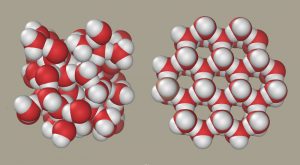How Freezing Temperatures Can Cause Roof Leaks…Even in Florida!
Did you know that Florida freezes can cause your roof to leak? That’s right, many building owners and managers are unaware of the dangers a freeze can have on your roof. Let’s take a look at what water does when it freezes and how it creates a roof leak.
When moisture is on your roof, whether through rain, dew, ponding water or HVAC discharge, it tends to pond in areas. For instance, rain ponding on a poorly maintained pitch pocket. Most liquids have a quite simple behavior when they are cooled (at a fixed pressure): they shrink. The liquids contract as it is cooled; because the molecules are moving slower they are less able to overcome the attractive intermolecular forces drawing them closer to each other. Then the freezing temperature is reached, and the substance solidifies which causes it to contract some more because crystalline solids are usually tightly packed.
Water is one of the few exceptions to this behavior, which is a problem to your roof. When liquid water is cooled, it contracts like one would expect until a temperature of approximately 4 degrees Celsius (39.2 degrees Fahrenheit) is reached. After that, it expands slightly until it reaches the freezing point of 0 degrees Celsius (32 degrees Fahrenheit), and then when it freezes it expands by approximately 9%, which herein lies the problem to your roof.
All the moisture that was trapped in the little cracks and voids in the roof and flashing will expand and make them much worse. Over the course of several freezes, these thermal ‘shock cycles’ create openings and cracks for water intrusion under the membrane, into the roof system, ultimately resulting in a roof leak.
How can you prevent this from occurring? There are two important steps. First, we need to make sure moisture is getting off of the roofing system. This means ensuring proper drainage, no areas or flashings that can hold water and confirming that all HVAC units have condensation lines that run to the drainage ports and are fully connected. Second, we have to make sure all voids, cracks, and damage to the roof is addressed and sealed accordingly. This includes pitch pockets, membrane voids, counter flashing sealants, etc.
With a few proper precautions and actions steps, we can ensure that your roof is protected when those night temperatures begin to drop below freezing, or better as you learned, 39.2 degrees.
Call RAMCON Today at 1-(877) 726-2661

